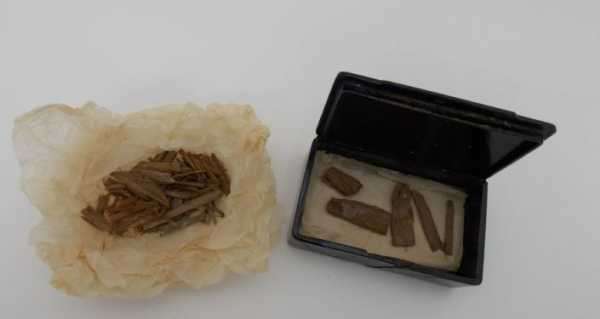
A trio of items were found by engineer Waynman Dixon inside the Great Pyramid of Giza’s Queens Chamber in 1872, and came to be known as the ‘Dixon relics’, with two – a ball and hook – finding their way to the British Museum, while one artefact has been missing for more than a century.
A relic from the Great Pyramid of Giza that has been missing for over a century has been miraculously recovered, quite by chance.
The artefact is a purportedly 5,000-year-old wooden fragment which is now in several pieces and has been hailed as a “hugely significant” discovery, writes The Guardian.
Curatorial assistant Abeer Eladany, who is originally from Egypt and did a 10-year stint working in the Egyptian Museum in Cairo, stumbled upon the artefact while reviewing items in the Asia collection of the University.
Her attention had been caught by a cigar box marked with her country’s former flag. As she opened it, Eladany found inside several wooden splinters.

A cigar tin that was found at the University of Aberdeen which contained fragments of cedar wood recovered from inside the pyramid at Giza
After cross-referencing the discovery with other records. she then identified it as the fragment of wood from the Great Pyramid which has been missing for more than a century.
Enthralled by the magnitude of the find, the woman said:
‘Dixon Relics’
The wooden fragment is one of three items discovered by engineer Waynman Dixon inside the pyramid’s Queens Chamber in 1872.
Known ever since as the ‘Dixon relics’, two – a ball and hook – have been housed at the British Museum in London. The third – a piece of cedar – was believed by experts to have been used during the pyramid’s construction, possibly as a measuring rule. If that were the case, it might hold clues to the mysteries behind the construction of the pyramid.

The Great Pyramid of Giza, Egypt
The cedar fragment was said to have originally belonged to a larger piece of wood, observed in a 1993 exploration of the interior of the pyramid by a robotic camera.
However, the artefact that was reportedly donated to the university in 1946 by Dixon’s friend, James Grant, could not be located. It had never been classified, and an extensive search failed to retrieve the item.
Carbon Dating Revelation
The discovery of the artefact has now raised new questions, as carbon dating has shown that the wood can be dated to the period 3341-3094 BC.

Pyramids of Giza
If correct, this is 500 years earlier than historical records which date the Great Pyramid to the reign of the Pharaoh Khufu in 2580-2560 BC.
Curtis added that scholars will now be able to study the artefact to determine its use and whether it was deliberately deposited in the Great Pyramid of Giza.
Sourse: sputniknews.com






